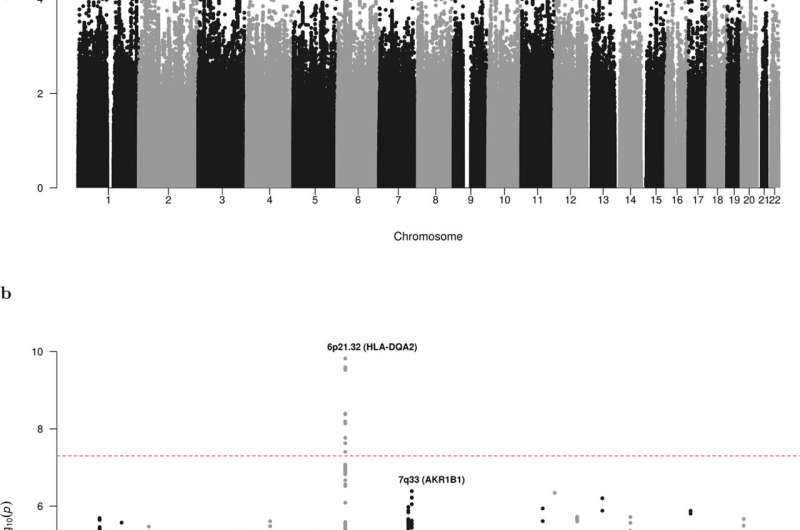Fig. 1: Manhattan plots from acute myeloid leukemia meta-analysis of 4 genome-wide association studies. For each GWAS, association tests were performed for all AML cases and cytogenetically normal AML assuming an additive genetic model, with nominally significant principal components included in the analysis as covariates. Association summary statistics were combined for variants common to all four GWAS, in fixed effects models using PLINK. Manhattan plots show negative log10 (fixed effects meta P values, Y axis) for all AML (a) and cytogenetically normal AML (b) over 22 autosomal chromosomes. Risk loci are annotated with chromosome position and local gene. All statistical tests were two-sided and no adjustments were made for multiple comparisons. The horizontal red line denotes the threshold for statistical significance in a genome-wide association study (P < 5.0 × 10−8). Credit: DOI: 10.1038/s41467-021-26551-x
Researchers have discovered that there is a genetic susceptibility to developing acute myeloid leukemia, a cancer of the white blood cells.
The condition can, at times, occur in relatives and is caused by single inherited gene mutations, although such families are rare. The genetic risk has not been understood by scientists, until now.
The Newcastle University-led study, published in Nature Communications, has proven that variation in certain genes plays a part in determining risk of developing familial acute myeloid leukemia (AML).
Genetic variants
Experts compared the DNA sequence from over 4,000 AML patients with DNA from over 10,000 healthy individuals. They found two genes with variations in their genetic sequences that are strongly associated with the development of AML.
Professor James Allan, from Newcastle University Centre for Cancer, who led the international study, said: "This is the first study to show that common genetic variants determine the risk of developing AML and it is the first step in explaining why some people get this disease and others do not.
"One of the genetic variants we found is located in a part of the genome that controls immunity and demonstrates that our own immune system plays an important role in detecting and eliminating AML cells.
"The body's immune system is known to play an essential part in protecting against numerous other cancers, but our study shows that immunity is very important in protecting against AML."
There are approximately 2,700 new diagnoses of AML each year in the UK and it is one of the deadliest forms of leukemia. Adults and children can get the illness, but it is most often diagnosed in older people.
AML can run in families but is extremely rare and does not make a major contribution to disease burden at the population level. Rather, most people who develop the condition have no family history of the illness.
Professor Allan said: "We need to do more research in this area to find out further what is happening. The two gene variants we have identified have a small effect on risk on their own. We need to increase the size of the study by adding more cases and controls in order to establish more variants that affect risk of AML. Once we have found more variants it will be much easier to predict who will develop AML and who will not."
More information: Wei-Yu Lin et al, Genome-wide association study identifies susceptibility loci for acute myeloid leukemia, Nature Communications (2021). DOI: 10.1038/s41467-021-26551-x
Journal information: Nature Communications
Provided by Newcastle University
























